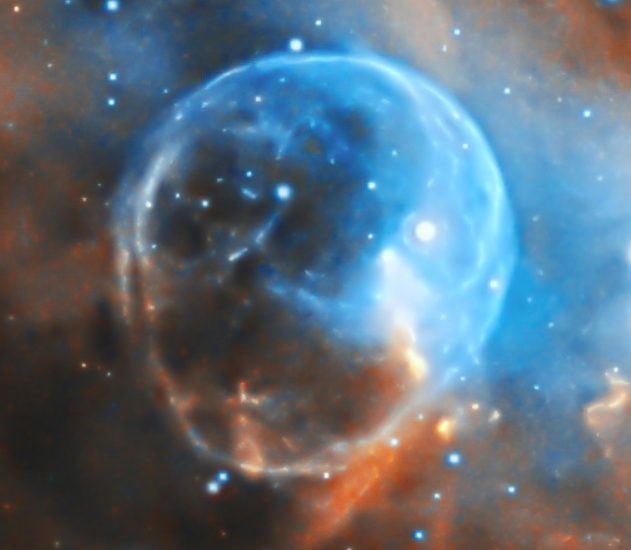It looks like you're using an Ad Blocker.
Please white-list or disable AboveTopSecret.com in your ad-blocking tool.
Thank you.
Some features of ATS will be disabled while you continue to use an ad-blocker.
26
share:
This Hubble image of NGC7635, or the Bubble Nebula was first
published in April 2016, but I only saw it yesterday when it was shared by the Hubble page on
Facebook:
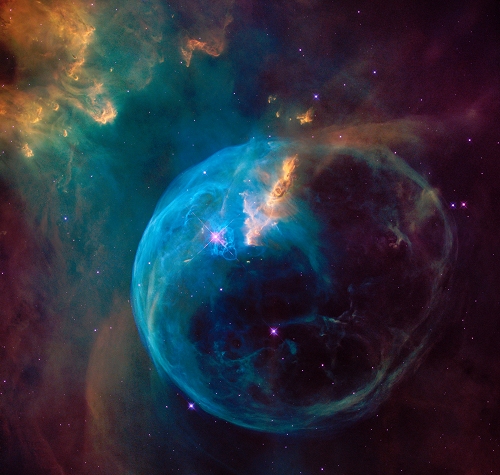
The image needs to be seen at its original scale to be fully appreciated: cdn.spacetelescope.org...
The "bubble" is blown into the interstellar medium by strong stellar winds from a massive star (visible in the top left side of the "bubble) within the nebula, compressing the material and also making various gasses in its surroundings glow due to strong UV emissions from the star. The glow from some of these gasses is captured in this image, using narrowband filters and assigning them specific colours for this false-colour image. Ionised Nitrogen has been assigned to red colour, ionised Hydrogen to green colour, and ionised Oxygen to blue colour.
~~~
In reality, emission nebulae like this one are mostly red in appearance, due to copious amounts of ionised Hydrogen. Ionised Nitrogen is also red, and ionised Oxygen is greenish-bluish in colour. Therefore, I decided to experiment and reassign the colours in the image to their true value, thus creating an approximately true-colour version of that image:

Full-scale image and more info: www.flickr.com...
I just love how delicate and intricate those strands of interstellar material look in and around the "bubble". Especially the small and intricate strands and loops near the star.
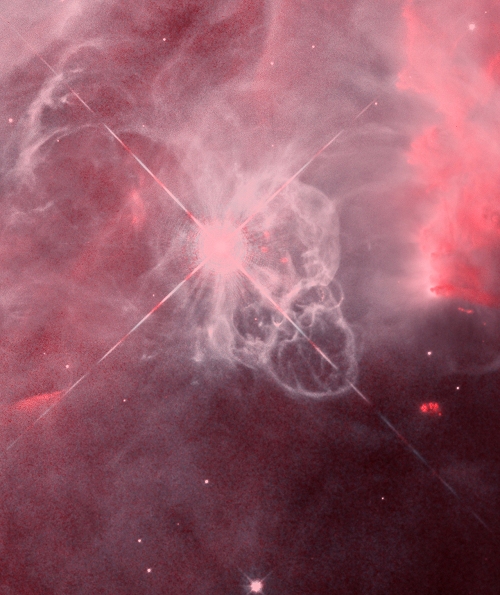

This new NASA/ESA Hubble Space Telescope image, released to celebrate Hubble’s 26th year in orbit, captures in stunning clarity what looks like a gigantic cosmic soap bubble. The object, known as the Bubble Nebula, is in fact a cloud of gas and dust illuminated by the brilliant star within it. The vivid new portrait of this dramatic scene wins the Bubble Nebula a place in the exclusive Hubble hall of fame, following an impressive lineage of Hubble anniversary images.
The image needs to be seen at its original scale to be fully appreciated: cdn.spacetelescope.org...
The "bubble" is blown into the interstellar medium by strong stellar winds from a massive star (visible in the top left side of the "bubble) within the nebula, compressing the material and also making various gasses in its surroundings glow due to strong UV emissions from the star. The glow from some of these gasses is captured in this image, using narrowband filters and assigning them specific colours for this false-colour image. Ionised Nitrogen has been assigned to red colour, ionised Hydrogen to green colour, and ionised Oxygen to blue colour.
~~~
In reality, emission nebulae like this one are mostly red in appearance, due to copious amounts of ionised Hydrogen. Ionised Nitrogen is also red, and ionised Oxygen is greenish-bluish in colour. Therefore, I decided to experiment and reassign the colours in the image to their true value, thus creating an approximately true-colour version of that image:

Full-scale image and more info: www.flickr.com...
I just love how delicate and intricate those strands of interstellar material look in and around the "bubble". Especially the small and intricate strands and loops near the star.

edit on 21-3-2018 by wildespace because: (no reason given)
a reply to: wildespace
So this is not a 'shock front', expanding from an explosive event, but a 'sphere of influence' bubble from steady emissions?
Kind of like a fluorescent tube but stronger (?)
If we know, what is the diameter of the bubble?
The "bubble" is blown into the interstellar medium by strong stellar winds from a massive star (visible in the top left side of the "bubble) within the nebula, compressing the material and also making various gasses in its surroundings glow due to strong UV emissions from the star.
So this is not a 'shock front', expanding from an explosive event, but a 'sphere of influence' bubble from steady emissions?
Kind of like a fluorescent tube but stronger (?)
If we know, what is the diameter of the bubble?
originally posted by: Skywatcher2011
a reply to: intrptr
Angry pacman face LOL
Good name, Pacman , in gobble mode.
originally posted by: intrptr
a reply to: wildespace
The "bubble" is blown into the interstellar medium by strong stellar winds from a massive star (visible in the top left side of the "bubble) within the nebula, compressing the material and also making various gasses in its surroundings glow due to strong UV emissions from the star.
So this is not a 'shock front', expanding from an explosive event, but a 'sphere of influence' bubble from steady emissions?
Kind of like a fluorescent tube but stronger (?)
If we know, what is the diameter of the bubble?
Yes, it's just a strong but steady stellar wind impinging on the interstellar material. The star is 44 times more massive than the Sun! The bubble is formed as a shock front where the stellar wind meets interstellar material at supersonic speeds. The wind from this star is travelling outwards at 1,800 - 2,500 km/s.
The bubble is approximately 7 light years across.
a reply to: wildespace
Sounds dangerous, thanks for the input. No wonder it has an angry face.
Sounds dangerous, thanks for the input. No wonder it has an angry face.
edit on 22-3-2018 by intrptr because: spelling
I decided to poke around the raw Hubble archive for the images that they used for that gorgeous image in
my OP, and made a couple of images myself detailing the clouds of gas and dust in and around the Bubble Nebula:
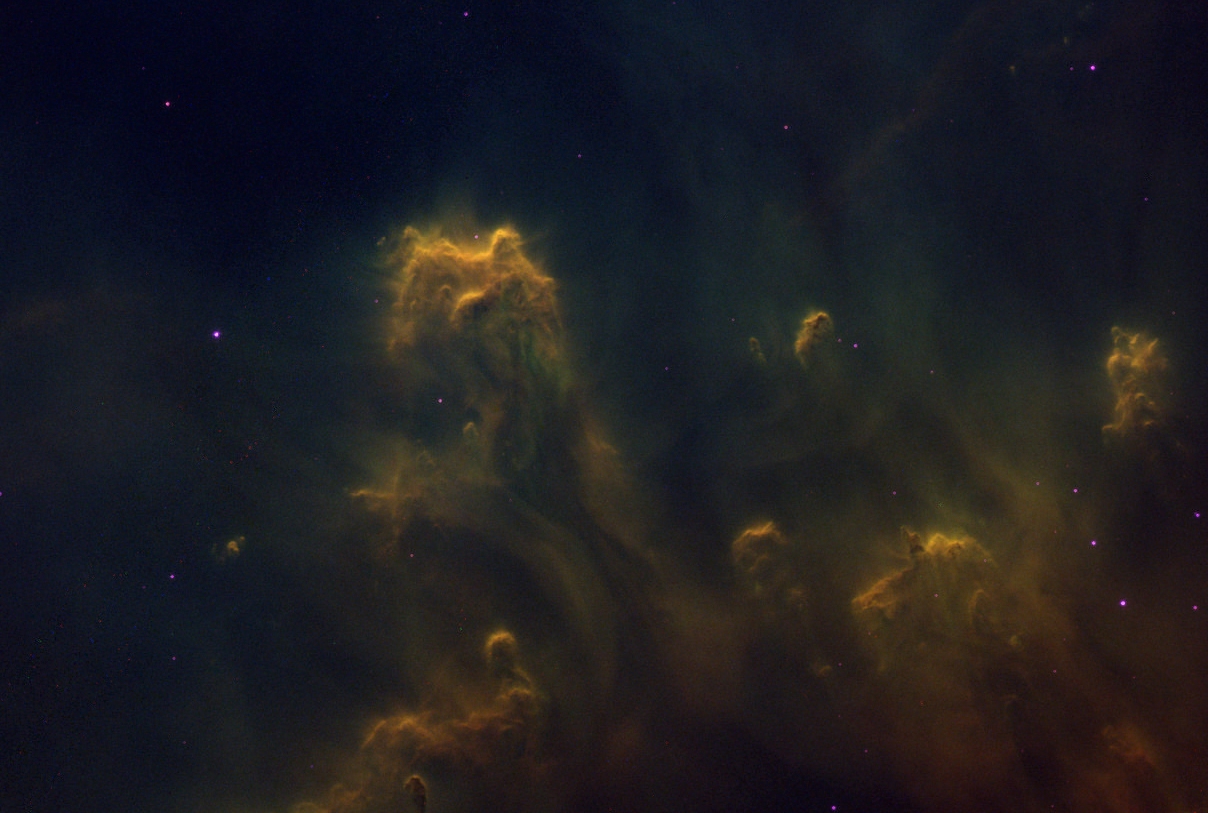
www.flickr.com...
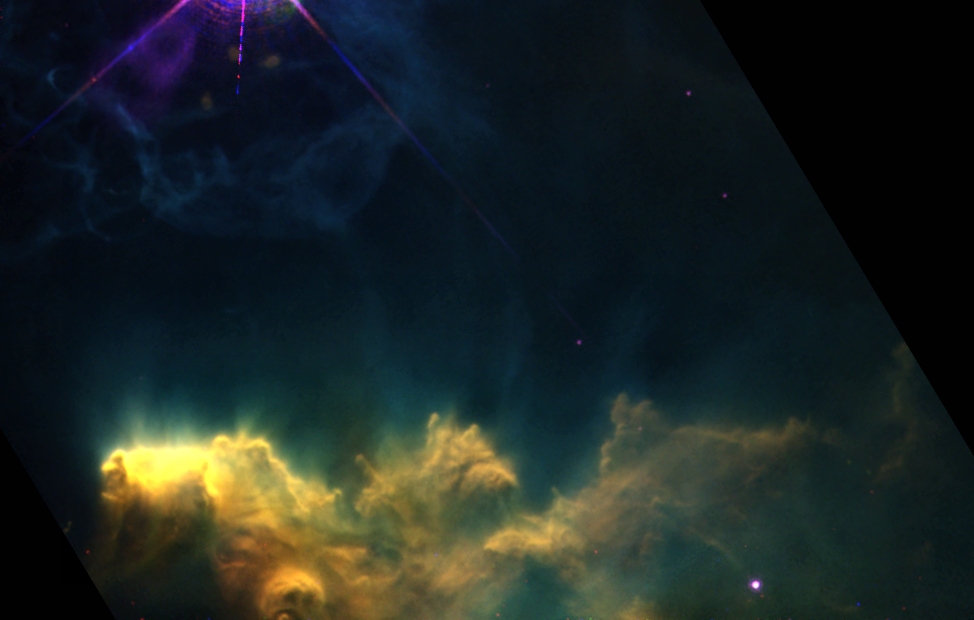
www.flickr.com...
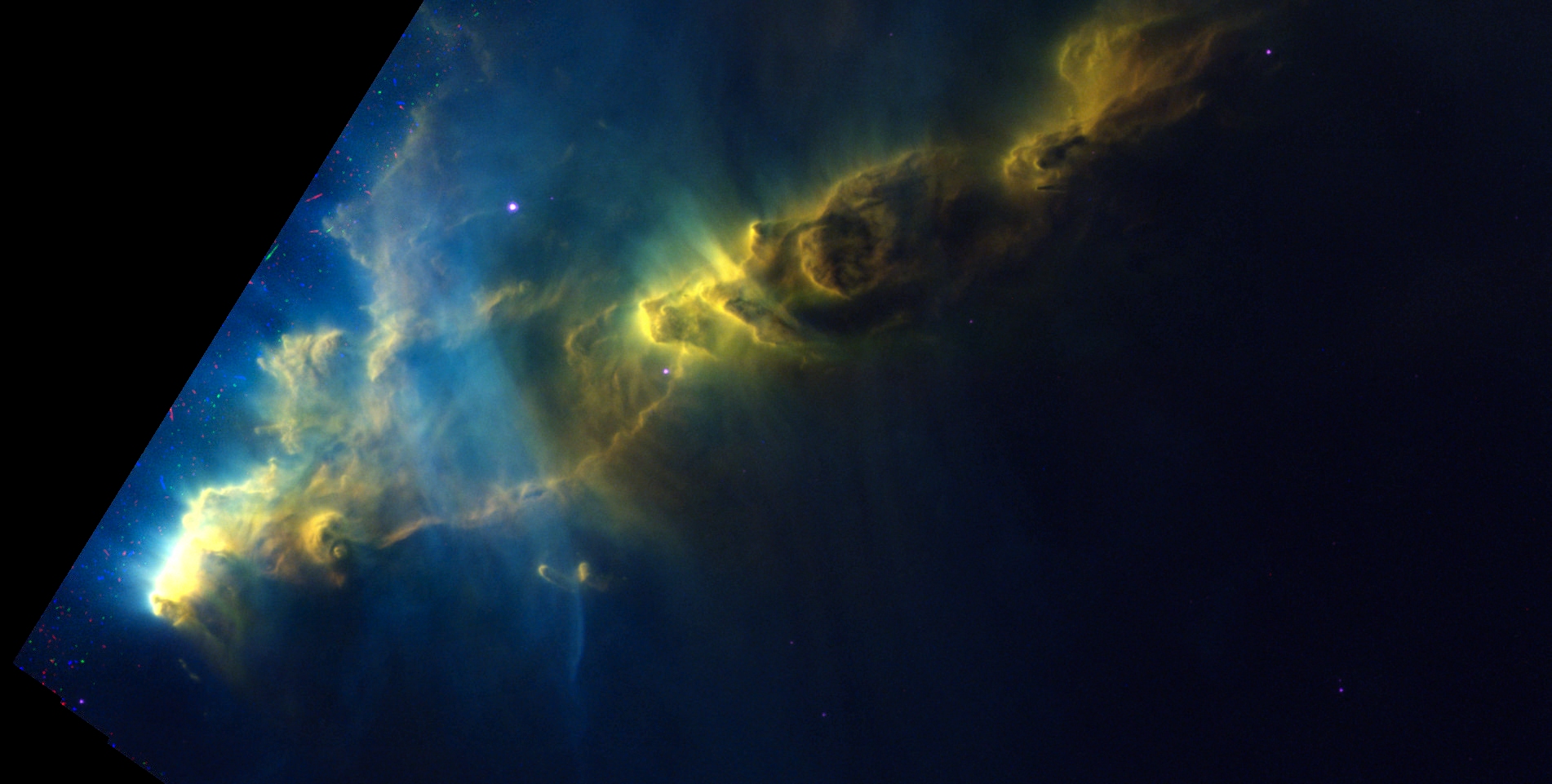
www.flickr.com...
There are some image artifacts like cosmic strikes, but I'm not a professional, so i think those came out pretty good.

www.flickr.com...

www.flickr.com...

www.flickr.com...
There are some image artifacts like cosmic strikes, but I'm not a professional, so i think those came out pretty good.
edit on 25-3-2018
by wildespace because: (no reason given)
A made a new version of the Hubble's image, this time using colour information from a
true-colour image by Adam Block.
Here's the result: www.flickr.com...
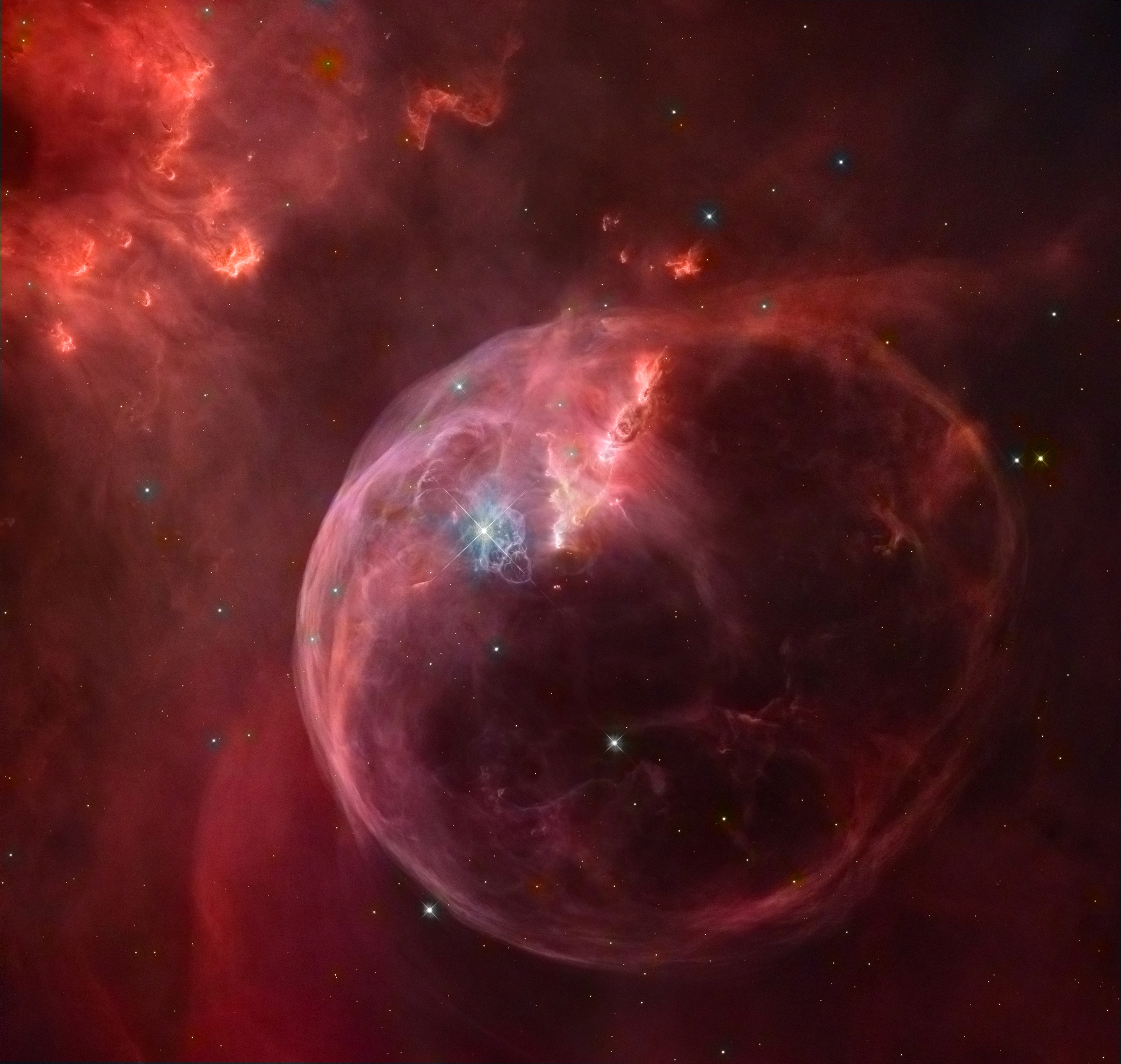
I think it looks a lot better and more pleasing to the eye than my first image.
Here's the result: www.flickr.com...

I think it looks a lot better and more pleasing to the eye than my first image.
*shameless plug*
My reprocessed version of the aforementioned Hubble image got to Astronomy Picture of the Day!
apod.nasa.gov...
My reprocessed version of the aforementioned Hubble image got to Astronomy Picture of the Day!
apod.nasa.gov...
Blown by the wind from a massive star, this interstellar apparition has a surprisingly familiar shape. Cataloged as NGC 7635, it is also known simply as The Bubble Nebula. Although it looks delicate, the 7 light-year diameter bubble offers evidence of violent processes at work. Above and left of the Bubble's center is a hot, O-type star, several hundred thousand times more luminous and some 45 times more massive than the Sun. A fierce stellar wind and intense radiation from that star has blasted out the structure of glowing gas against denser material in a surrounding molecular cloud. The intriguing Bubble Nebula and associated cloud complex lie a mere 7,100 light-years away toward the boastful constellation Cassiopeia. This sharp, tantalizing view of the cosmic bubble is a composite of Hubble Space Telescope image data from 2016, reprocessed to present the nebula's intense narrowband emission in an approximate true color scheme.
new topics
-
Top Sci Fi/Horror Crossover Movies
Movies: 22 minutes ago -
Magic Vaporizing Ray Gun Claim - More Proof You Can't Believe Anything Hamas Says
War On Terrorism: 1 hours ago -
One out of every 20 Canadians Dies by Euthanasia
Medical Issues & Conspiracies: 1 hours ago -
USS Liberty - I had no idea. Candace Owen Interview
US Political Madness: 2 hours ago -
What Am I Hearing
General Chit Chat: 10 hours ago
top topics
-
A Bunch of Maybe Drones Just Flew Across Hillsborough County
Aircraft Projects: 16 hours ago, 9 flags -
USS Liberty - I had no idea. Candace Owen Interview
US Political Madness: 2 hours ago, 9 flags -
Magic Vaporizing Ray Gun Claim - More Proof You Can't Believe Anything Hamas Says
War On Terrorism: 1 hours ago, 5 flags -
Who's coming with me?
General Conspiracies: 17 hours ago, 4 flags -
What Am I Hearing
General Chit Chat: 10 hours ago, 3 flags -
One out of every 20 Canadians Dies by Euthanasia
Medical Issues & Conspiracies: 1 hours ago, 3 flags -
Top Sci Fi/Horror Crossover Movies
Movies: 22 minutes ago, 3 flags
active topics
-
And Here Come the Excuses!!
General Conspiracies • 189 • : matafuchs -
Mood Music Part VI
Music • 3734 • : underpass61 -
Will all hell break out? Jersey drones - blue beam
Aliens and UFOs • 45 • : imitator -
A Bunch of Maybe Drones Just Flew Across Hillsborough County
Aircraft Projects • 23 • : matafuchs -
Top Sci Fi/Horror Crossover Movies
Movies • 0 • : Roma1927 -
One out of every 20 Canadians Dies by Euthanasia
Medical Issues & Conspiracies • 3 • : onestonemonkey -
-@TH3WH17ERABB17- -Q- ---TIME TO SHOW THE WORLD--- -Part- --44--
Dissecting Disinformation • 3635 • : duncanagain -
USS Liberty - I had no idea. Candace Owen Interview
US Political Madness • 4 • : charlest2 -
Magic Vaporizing Ray Gun Claim - More Proof You Can't Believe Anything Hamas Says
War On Terrorism • 1 • : Athetos -
Drones everywhere in New Jersey
Aliens and UFOs • 74 • : imitator
26

